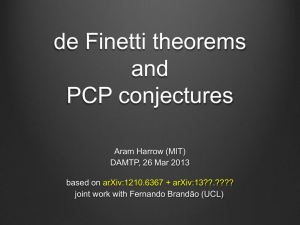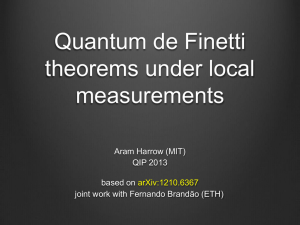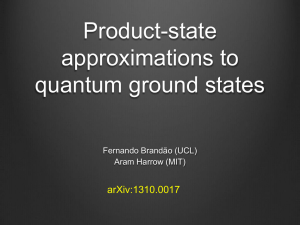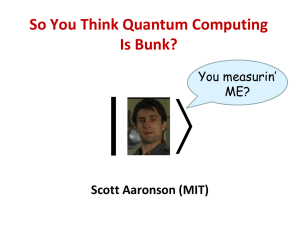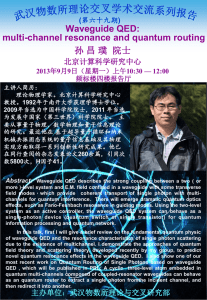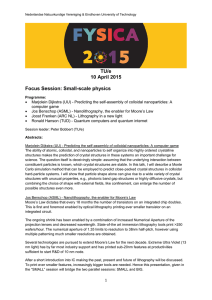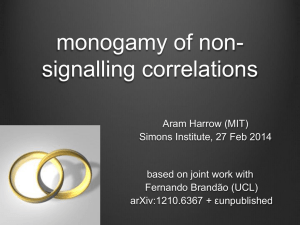ppt - MIT
advertisement
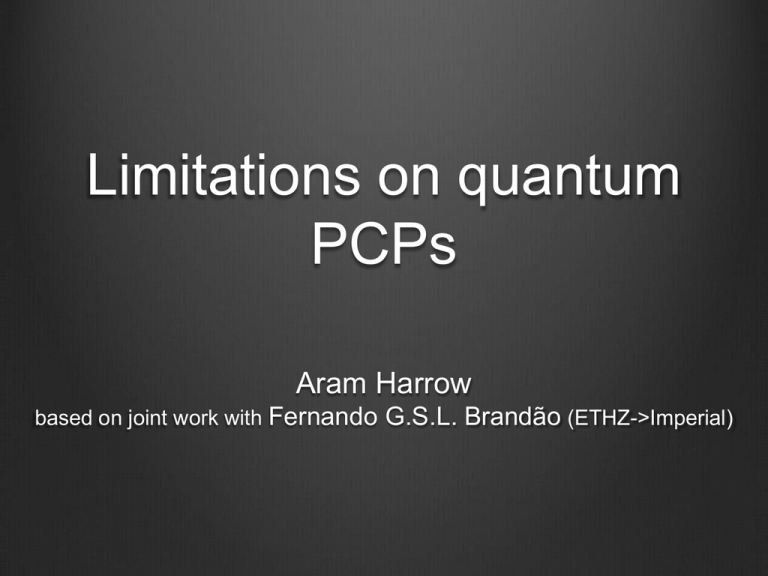
Limitations on quantum
PCPs
Aram Harrow
based on joint work with Fernando G.S.L. Brandão (ETHZ->Imperial)
PCP theorem
Classical k-CSPs:
Given constraints C={Ci}, choose an assignment σ mapping n variables to
an alphabet ∑ to minimize the fraction of unsatisfied constraints.
UNSAT(C) = minσ Pri [σ fails to satisfy Ci]
Example: 3-SAT:
NP-hard to determine if UNSAT(C)=0 or UNSAT(C) ≥ 1/n3
PCP (probabilistically checkable proof) theorem:
NP-hard to determine if UNSAT(C)=0 or UNSAT(C) ≥ 0.1
quantum background
Density matrices
A quantum state on n qubits is described by a 2nx2n [density] matrix ρ
satisfying ρ≥0 and trρ=1.
Classical analogue:
Diagonal density matrices
probability distributions
Tensor product:
ρA
ρB
ρZ
ρA ρB … ρZ
Local Hamiltonian problem
LOCAL-HAM: k-local Hamiltonian ground-state energy estimation
Let H = 𝔼i Hi, with each Hi acting on k qubits, and ||Hi||≤1
i.e. Hi = Hi,1 ⊗ Hi,2 ⊗ … ⊗ Hi,n, with #{j : Hi,j≠I} ≤ k
Goal:
Estimate E0 = min½ tr Hρ
Hardness
• Includes k-CSPs, so ±0.1 error is NP-hard by PCP theorem.
• QMA-complete with 1/poly(n) error [Kitaev ’99]
QMA = quantum proof, bounded-error polytime quantum verifier
Quantum PCP conjecture
LOCAL-HAM is QMA-hard for some constant error ε>0.
Can assume k=2 WLOG [Bravyi, DiVincenzo, Terhal, Loss ‘08]
high-degree in NP
Theorem
It is NP-complete to estimate E0 for n qudits on a D-regular graph
(k=2) to additive error » d / D1/8.
Idea: use product states
E0 ≈ min tr H(ρ1 … ρn) – O(d/D1/8)
By constrast
2-CSPs are NP-hard to approximate to error
|§|®/D¯ for any ®,¯>0
mean-field theory
1-D
∞-D
2-D
3-D
Folk theorem
high-degree interaction graph
symmetric ground state
≈ tensor power ground state
quantum de Finetti theorem
Theorem [Christandl, Koenig, Mitchison, Renner ‘06]
Given a state
, there exists µ such that
builds on work by [Størmer ’69], [Hudson, Moody ’76], [Raggio, Werner ’89]
[Caves, Fuchs, Sachs ‘01], [Koenig, Renner ‘05]
Proof idea:
Perform an informationally complete measurement of n-k B systems.
QUANTUM
CLASSICAL
measurement
Pr[1] = tr ρM1
ρ
1
Pr[2] = tr ρM2
2
Density matrix
tr ρ = 1
ρ≥0
{M1, …, Mk}
Pr[k] = tr ρMk
Measurement
M1 + … + Mk = I
Mi ≥ 0, ∀i
M is informationally complete ⟺ M is injective
k
information theory tools
1. Mutual information:
2. Pinsker’s inequality:
3. Conditional mutual information:
I(X:Y|Z) = I(X:YZ) – I(X:Z)
4. Chain rule:
I(X:Y1…Yk) = I(X:Y1) + I(X:Y2|Y1) + … + I(X:Yk|Y1…Yk1)
I(X:Yt|Y1…Yt-1) ≤ log(|X|)/k for some t≤k.
conditioning decouples
Idea that almost works: [c.f. Raghavendra-Tan ‘11]
1. Choose i, j1, …, jk at random from {1, …, n}
Then there exists t<k such that
2. Discarding systems j1,…,jt causes error ≤k/n and leaves a
distribution q for which
quantum information?
Nature isn't classical, dammit, and if
you want to make a simulation of
Nature, you'd better make it quantum
mechanical, and by golly it's a
wonderful problem, because it
doesn't look so easy.
a physicist
Good news
Bad news
• Only definition of I(A:B)ρ is as
H(A)ρ + H(B)ρ - H(AB)ρ.
• Can’t condition on quantum
information.
• I(A:B|C)ρ ≈ 0 doesn’t imply ρ is
approximately separable
[Ibinson, Linden, Winter ‘08]
Good news we can use:
Informationally-complete measurement M satisfies
• I(A:B), I(A:B|C), etc. still defined
• Pinsker, chain rule, etc. still hold
• I(A:B|C)ρ=0 $ ρ is separable
d-3 || ½ - ¾ ||1 ≤ || M(½) - M(¾) ||1 ≤ || ½ - ¾ ||1
proof overview
1. Measure εn qudits and condition on outcomes.
Incur error ε.
2. Most pairs of other qudits would have mutual
information
≤ log(d) / εD if measured.
3. ∴ their state is within distance d3(log(d) / εD)1/2 of
product.
4. Witness is a global product state. Total error is
ε + d3(log(d) / εD)1/2.
Choose ε to balance these terms.
other applications
PTAS for Dense k-local Hamiltonians
improves on 1/dk-1 +εapproximation from [Gharibian-Kempe ’11]
PTAS for planar graphs
Builds on [Bansal, Bravyi, Terhal ’07] PTAS for
bounded-degree planar graphs
Algorithms for graphs with low threshold rank
Extends result of [Barak, Raghavendra, Steurer ’11].
run-time for ε-approximation is
exp(log(n) poly(d/ε) ⋅#{eigs of adj. matrix ≥ poly(ε/d)}
quantum Lasserre
Previously proposed by [Barthel-Hübener ‘11], [Baumgartz-Plenio ‘11] building
on [Erdahl ’78], [Yasuda-Nakatsuji ’97], [Nakatsuji-Yasuda ’04], [Mazziotti ‘04]
Si = set of ≤k systems acted on by Hi
First attempt:
Variables are r-body marginals ρS with |S|≤k.
Enforce consistency constraints on overlapping S1, S2.
Global PSD constraint:
For k/2 – local Hermitian operators X, Y, define hX,Yi := tr ρXY.
Require that h¢
, ¢i be PSD.
(Classical analogue = covariance matrix.)
BRS11 analysis + local measurement ⇒ suffices to take
r ≥ poly(d/ε) ⋅#{eigs of adj. matrix ≥ poly(ε/d)}
Open questions
1. The Quantum PCP conjecture!
Gap amplification, commuting case, thermal states
Better ansatzes
2. Quantum Lasserre for analogue of unique games?
1. better de Finetti/monogamy-of-entanglement theorems
hoping to prove
a) QMA(2 provers, m qubits) ⊆ QMA(1 prover, m2 qubits)
b) MIP* ⊆ NEXP. [cf. Ito-Vidick ’12]
c) exp(polylog(n)) algorithm for small-set expansion
de Finetti without symmetry
Theorem [Christandl, Koenig, Mitchison, Renner ‘05]
Given a state
, there exists µ such that
Theorem
For ρ a state on A1A2…An and any t ≤ n-k, there exists m≤t such that
where σ is the state resulting from measuring j1,…,jm and obtaining
outcomes a1,…,am.
QC de Finetti theorems
Idea
Everything works if at most one system is quantum.
Or if all systems are non-signalling (NS) boxes.
Theorem
If ρAB has an extension
that is symmetric on the
B1,…,Bn systems, and {¤A,m}m is a distribution over maps with
a d-dimensional output, then
Corollary [cf Brandao-Christandl-Yard ‘10]
QCC…C de Finetti
Theorem
If
exists µ s.t.
is permutation symmetric then for every k there
Applications
• QMA = QMA with multiple provers and Bell measurements
• free non-local games are easy
• convergence of sum-of-squares hierarchy for polynomial
optimization
• Aaronson’s pretty-good tomography with symmetric states

